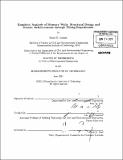Empirical analysis of masonry walls : structural design and seismic reinforcement through tilting experiments
Author(s)
Jimenez, Daniel D. (Daniel David)
DownloadFull printable version (22.20Mb)
Alternative title
Structural design and seismic reinforcement through tilting experiments
Other Contributors
Massachusetts Institute of Technology. Dept. of Civil and Environmental Engineering.
Advisor
John A. Ochsendorf.
Terms of use
Metadata
Show full item recordAbstract
Masonry is a fundamental building material that is used for a significant proportion of structures across the world, many of which lie in potentially hazardous environments. While masonry naturally has poor performance under lateral loads which lead to tensile forces, many of these structures lie within highly seismic regions. As a result, guidelines have been established to ensure structural integrity in case of a disaster, yet these are based on assumptions that limit the accuracy of these tools, and fail to address the needs of traditional non-engineered masonry environments. This thesis begins with an overview of seismic hazards and the effects they have on the structural design of unreinforced masonry. The failure modes of masonry structures are discussed, followed by an evaluation of reinforcement techniques and their effects on structural behavior. A comparison of quasi-static and dynamic analytical methods, and their conditional accuracies provides an argument towards a simplified approach to masonry modeling that is appropriate for engineering applications. The methodology of this thesis applies a quasi-static tilt analysis through the physical modeling of masonry structures with discrete scaled masonry blocks. The results of initial experiments support the validity of this model in representing predicted masonry behavior, leading to a series of experiments on a selection of masonry designs and the analysis of reinforcement modeling techniques. Further research can expand on the structural designs and reinforcement materials, and use the physical models in more complex load applications, for example, with a shaking table.
Description
Thesis (M. Eng.)--Massachusetts Institute of Technology, Dept. of Civil and Environmental Engineering, 2011. Cataloged from PDF version of thesis. Includes bibliographical references (p. 91-92).
Date issued
2011Department
Massachusetts Institute of Technology. Department of Civil and Environmental EngineeringPublisher
Massachusetts Institute of Technology
Keywords
Civil and Environmental Engineering.